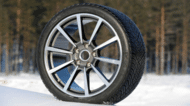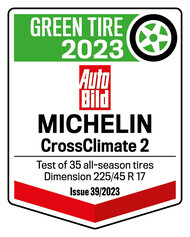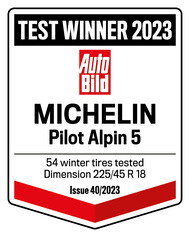
Winter tyre or snow tyre: what is it?

What is a winter tyre? Is it different from a snow tyre?
Find out what you need to know about winter tyres and when it is advisable for your vehicle to be fitted with them.

Winter tyre are tyres specifically designed to drive safely in temperatures below 7ºC, whether the road is snowy or not.
They are identified by special markings, M+S and/or 3PMSF, situated on the sidewall of the tyre.
There isn’t really much of a difference. These terms have evolved over time and with the development of new technology.
These days, they are most commonly referred to as winter tyres, because their benefits can be felt not only on snowy roads, but in all winter conditions, in particular on wet road surfaces at temperatures < 7°C.
Summer tyres are noticeably less effective when the temperature drops. The hardened rubber that results from lower temperatures leads to poor grip on the road. This is why we recommend changing your tyres as soon as the temperature begins to fall below 7 °C.
Developed for the demands of winter driving, winter tyres are made with materials which adapt to the cold. Whether on dry, wet, snowy or icy ground, their flexible rubber coupled with deep tread guarantees better surface grip. The road handling and driveability of the vehicle are optimised, and the braking distance reduced.

In winter, driving conditions can be very changeable, and road surfaces can range from dry to humid, wet to snowy or icy. No matter what, the weather is bound to be cold—which is why it’s important to use tyres suited to winter weather, like winter or all season tyres, on your vehicle.
In the world of tyres, winter starts as soon as the temperature drops below 7°C.
So that’s when it’s generally recommended to switch to your winter tyres. At this temperature, the rubber in your tyres hardens and becomes less efficient.
Snow, ice, black ice: motorists can feel less safe driving in winter. But it doesn’t have to be that way.
By correctly accounting for the risk factors of driving in cold weather and ensuring you have equipment suited to the winter conditions (winter tyres or 3PMSF-certified all season tyres), you can feel just as safe in winter as you do on a nice summer day.

Drivers tend to believe that snow and ice are the biggest hazards for winter driving. And yet, 9 accidents out of 10* occur on dry or wet roads, rather than road surfaces covered in snow or ice.
Snow can be a hazard, but it’s far from the only one. Even in the winter, nearly 9 out of 10 incidents* occur on a straight road.
How is this phenomenon explained? It’s a question of concentration. Drivers tend to be much more vigilant on hairpin turns and coming out of blind turns, while when driving on straight city roads with good visibility they let their attention wander. As a result, the number of accidents is significantly higher in urban areas.
In conditions like these, your tyres play an even more important role, which is why it is important to equip your car with either winter tyres or all season tyres.
*Road Accident Research Institute (VUFO) - University of Dresden: 12,000 accidents analysed over an average of 12 years.
Winter tyre treads are easily recognisable as they feature numerous, fine, deep cuts. These are commonly known as “sipes”.
These sipes are located on the tyre tread act like “claws”, ensuring optimal performance in dry, wet, snowy and icy terrain.
Winter tyres have better grip than summer tyres in temperatures less than 7ºC, as they are designed with:


Winter tyres also differ from summer tyres in terms of the chemical composition of their rubber. It is formulated to stay soft even in low temperatures, increasing its grip on slippery surfaces (wet, snowy or icy conditions).
- At low temperatures (less than 7ºC), the rubber on the treads of summer tyres hardens, inhibiting their ability to grip the ground.
- The unique composition of winter tyres allows them to remain flexible and grip the road surface effectively.
There are many reasons to use specially adapted tyres (winter or all season) when the temperature starts to drop.
While the 3PMSF mark is a guarantee of safety and mobility in the snow, tyres with this mark are also designed to perform well on cold and slippery surfaces, whether wet or icy.
At temperatures below 7 ° C, certified winter tyres (with the M + S or 3PMSF markings) are safer and have a shorter stopping distance than summer tyres on wet, snowy or icy roads.

If you only drive in wintery conditions such as snow or ice occasionally, tyres from the MICHELIN CrossClimate range are perfect for you.
If, however, you are regularly faced with harsh weather conditions, the MICHELIN Alpin range has what it takes to safely get you where you need to go.
Passenger Car
SUV & 4x4
Electric or hybrid car




MICHELIN CROSSCLIMATE 2, the expert in the all season tyre category[1].
SUV & 4x4
Electric or hybrid car

Road control made to last in severe winter conditions for your SUV.
Passenger Car
SUV & 4x4
Electric or hybrid car


Road control made to last in severe winter conditions.